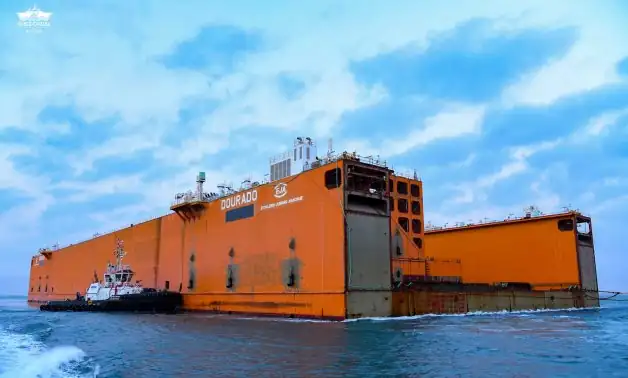CAIRO – 8 November 2024: The Suez Canal Authority (SCA) announced on Friday the successful transit of the massive DOURADO barge, a landmark crossing that marked the largest operation in the canal’s history.
Spanning 90 meters wide, the barge represents a milestone in the Egyptian waterway’s capabilities, a feat made possible by recent expansion efforts, according to SCA Chairman Osama Rabie.
The ambitious journey, taking nearly 24 hours to complete, required advanced navigational strategies to steer the 91,000-ton floating unit along the canal’s new, expanded route.
A coordinated team of senior SCA navigators and tugboat captains, alongside a fleet of seven guiding tugs, ensured the DOURADO barge maintained its path northbound from Singapore to Turkey, heeding careful adjustments to both air and water currents to stay centered within the canal.
Rabie emphasized that such a crossing would not have been feasible prior to the canal’s recent enhancements.
“DOURADO’s passage underscores the achievements of the canal’s expansion project in the southern sector, enabling the waterway to accommodate significantly larger vessels than before,” he said in an SCA statement.
The expansive convoy, including the barge and accompanying tugs, extended to an impressive 450 meters in length.
For the journey, DOURADO relied solely on the towage and navigational guidance of the SCA tugs, necessitating precision maneuvering to safely traverse the canal’s length.
A New Era of Canal Capabilities
The crossing marked the latest achievement for the Suez Canal since the completion of the expansion project’s initial phase in 2023.
The southern sector project widened the canal by 40 meters along the eastern side, bringing the total width to an unprecedented 110 meters in some areas.
Before these upgrades, the canal could only handle vessels with a maximum width of 70 meters, limiting the types of ships and floating units that could make the passage.
These enhancements have significantly reduced the influence of water currents on vessels navigating the canal and have strengthened overall maritime safety measures within the southern sector, Rabie noted.
With this wider channel, the canal is now positioned to host previously ineligible floating units, further securing its position as a vital international maritime corridor.
Expanding the Southern Sector
The DOURADO’s crossing reflects the SCA’s continued efforts to improve the waterway’s infrastructure, with the first phase of the southern sector expansion spanning between the 132 and 162 km markers.
The second phase of the project, covering the stretch from 122 to 132 km in the Small Bitter Lake region, is already 76 percent complete, according to the SCA.
This historic operation follows the 2016 inauguration of a new canal segment at the northern end, a project that marked the start of a broader modernization strategy aimed at increasing traffic capacity, enhancing transit speeds, and boosting safety for international vessels.
Rabie added that the completion of these strategic expansions reaffirms the Suez Canal’s status as one of the world’s most important waterways, capable of supporting larger and more varied types of maritime traffic.
As larger ships, barges, and other floating units like DOURADO continue to seek passage, the canal’s expanded infrastructure offers enhanced capacity and navigational flexibility, ensuring its readiness for the demands of future global trade.

